Moving Orchids Indoors for Winter
Summer is slipping away it's time to move your plants back indoors for the winter. Summer vacation is over.
Bringing your orchids indoors after they've spent the summer outdoors changes their growing environment and can be stressful for the plants.
Making the move indoors can be easy (for both you and your plants) with a little planning. Here are a few things to consider.
Hydroponic Advantage:
Before Moving Indoors
1. Prepare your indoor growing area. This can be a sunny window or under grow lights. East or west windows are okay, but south windows are the best. North facing windows don't have enough direct sun and simply won't due. Remember, we're trying to mimic the growing environment they experienced outdoors.
2. Choose which plants are going to make the move. Sometimes you have to make tough choices. Any plant that has been struggling all summer outdoors won't improve indoors. Time to let go and send it to plant heaven. Pests and disease can spread quickly.
3. Tools you'll need:
- Neem Oil
- Soap and Water (any dish soap will do)
- Soft brush
Making the Move
Bringing plants back indoors for winter isn't as simple as moving them from one place to another. It's always a good idea to take precautions to avoid bringing in any creepy crawlers from outdoors. No hitchikers allowed!
A little TLC might also be needed while they adjust to their new growing environment indoors.
1. Give all your plants a bath. Healthy plants have a natural resistance to insects and disease so it's unlikely your plants have attracted unwanted pests. It's always a good idea to give them all a soapy bath before the trip indoors however. This is easy with hydroponics!
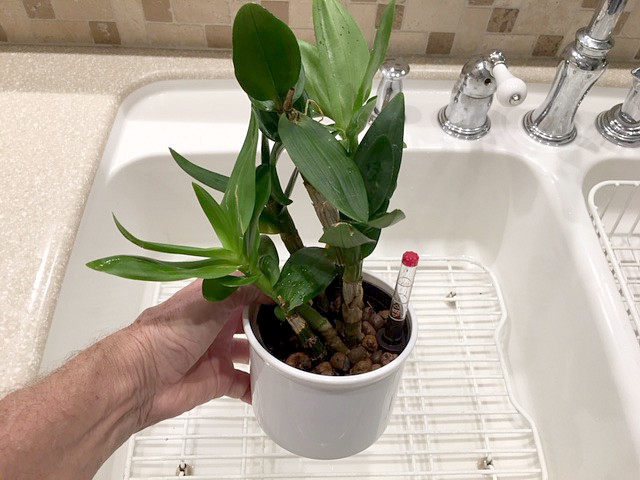 Here's a Dendrobium that enjoyed a terrfic growing season outdoors. Time to come in for winter.
Here's a Dendrobium that enjoyed a terrfic growing season outdoors. Time to come in for winter.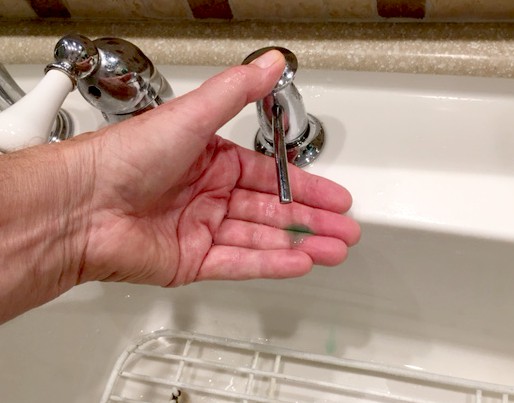 I'm going to give the plant a soapy bath before. Start with a couple of drops of dish soap.
I'm going to give the plant a soapy bath before. Start with a couple of drops of dish soap.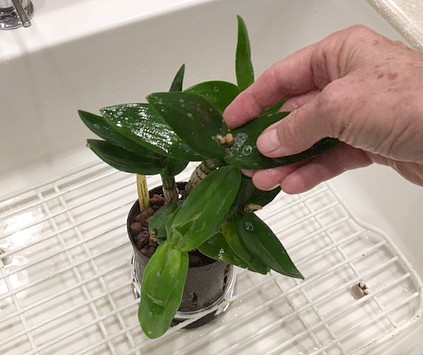 Using your fingers, carefully wash all the leaves - top and bottom. Don't worry about soap suds getting into the grow pot. Hydroponic plants have water roots and welcome a soapy bath.
Using your fingers, carefully wash all the leaves - top and bottom. Don't worry about soap suds getting into the grow pot. Hydroponic plants have water roots and welcome a soapy bath.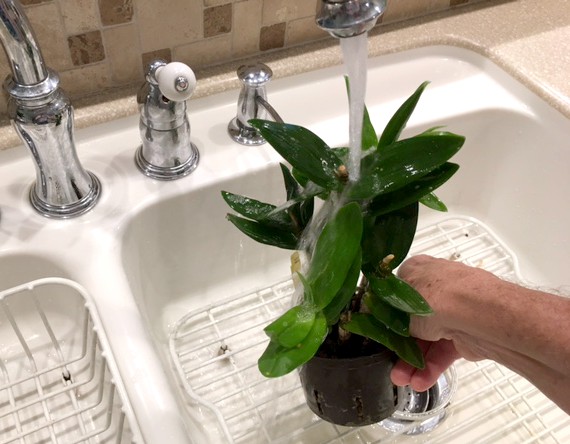 Wash away the dirt and grime that may have acumulated on the leaves outdoors.
Wash away the dirt and grime that may have acumulated on the leaves outdoors.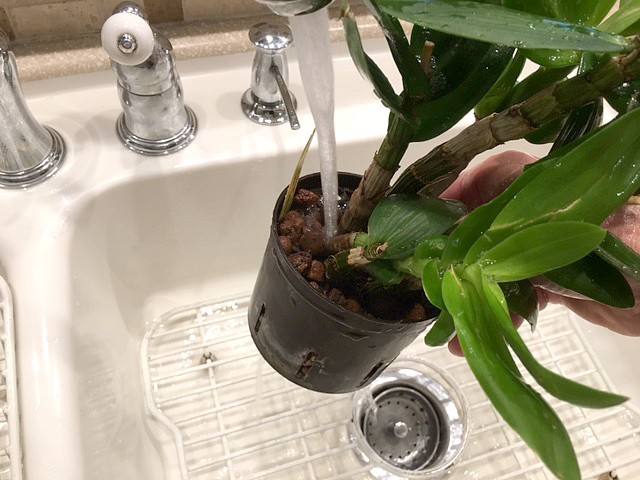 Refresh the roots by holding plant under faucet for a couple of seconds to wash away any impurities that may have acumulated in the grow pot.
Refresh the roots by holding plant under faucet for a couple of seconds to wash away any impurities that may have acumulated in the grow pot.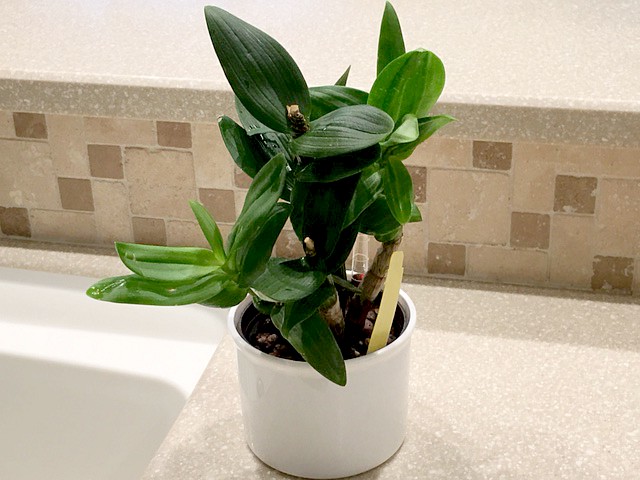 Return plant to outer pot. It's ready for the winter season.
Return plant to outer pot. It's ready for the winter season.
Suspect Insects?
Sooner or later you'll find a plant that has attracted insects outdoors. In most cases, insects are not difficult to eradicate if you take the right steps.
If you suspect insects, spray with Neem Oil. Neem oil is an effective control for all insects. and it's completely safe to use.
1. Mix 1 tbs of Neem Oil with 1 qt of water in your sprayer.
2. Add a drop or two of dish soap (only a drop or two or you'll have a river of suds!). Shake sprayer to mix thoroughly.
3. Spray plant throughly - including the underside of leaves. Spray pebbles and grow pot too.
4. Repeat this spray routine once a week for 3 weeks - whether you see insects or not.
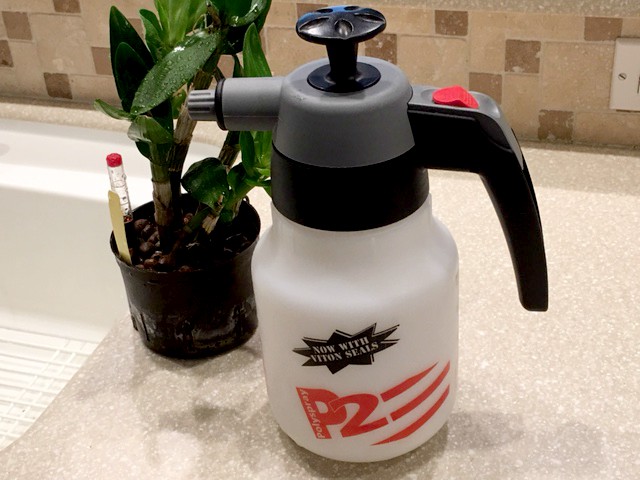 The most important tool for fighting insects is a good sprayer.
The most important tool for fighting insects is a good sprayer.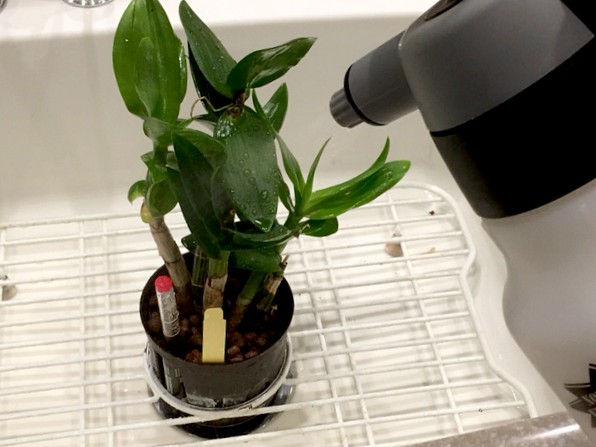 Spray plant thoroughly - continue until Neem solution dripping from the leaves.
Spray plant thoroughly - continue until Neem solution dripping from the leaves.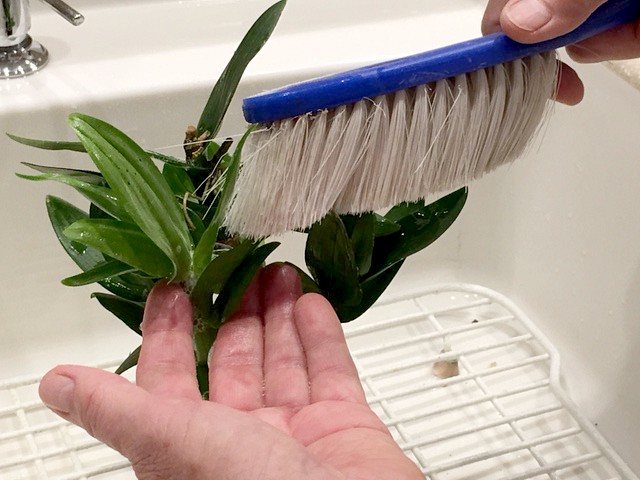 Holding leaves with one hand for support, gently scrub leaves with a soft brush to dislodge insects.
Holding leaves with one hand for support, gently scrub leaves with a soft brush to dislodge insects.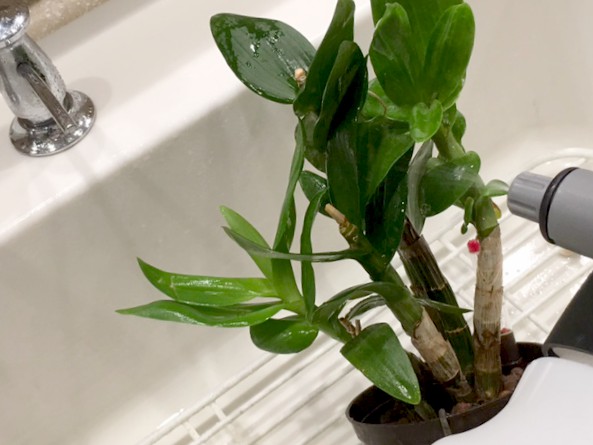 Spray underside of all the leaves.
Spray underside of all the leaves.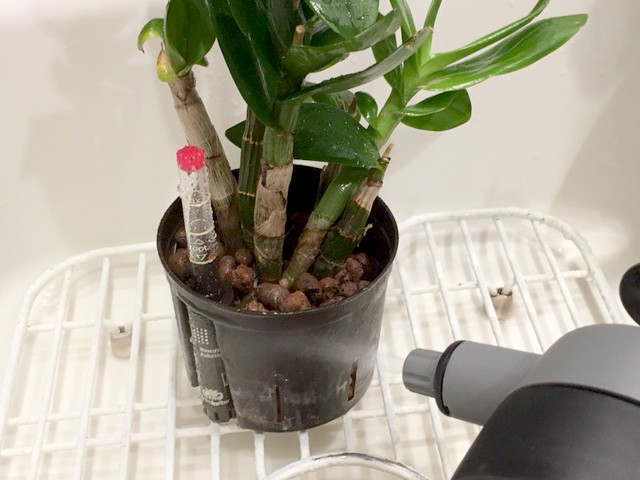 Spray grow pot too - insects lay eggs anywhere!
Spray grow pot too - insects lay eggs anywhere!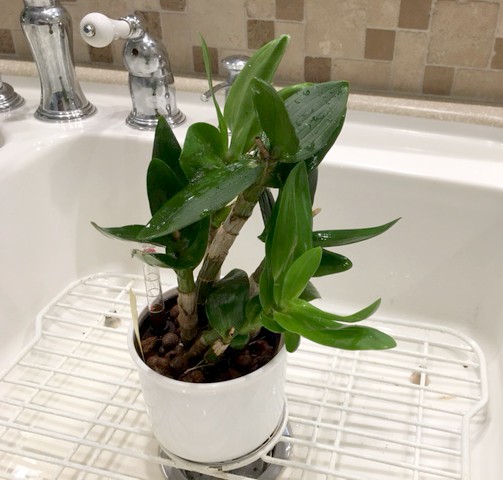 Good job! Return plant to its outer pot. Good idea to quarrantine plant until the 3 week spray program is completed.
Good job! Return plant to its outer pot. Good idea to quarrantine plant until the 3 week spray program is completed.
Plant Care Indoors
After your plants are in their new home for winter you'll want to make some adjustments with your plant care. Their growing environment has is changed and so should your plant care.
The good news is - they've been building up energy outdoors all summer and many are preparing to bloom. Proper plant care can make the difference between enjoying magnificent blooms or settling for plain green stems.
Light - Adequate light is key to growing healthy plants that's especially true for orchids that have just been brought indoors. Even though your plants needed protection from the sun outdoors, they will need some sun indoors. East or west windows are okay, with south facing windows being the best. Windows that face north simply don't have enough sun and won't due.
Water - Overwatering is the biggest problem with plants that have just come in from outdoors. Their growth rate slows dramatically indoors and your watering should too!
The water gauge in our hydroponic system makes correct watering easy. Generally speaking, give your plants about 1/2 the amount of water they were getting outdoors. For example, a plant that was watered to 1/2 on gauge outdoors will only get 1/4 on the gauge indoors. Make sure the system is completely dry before rewatering. Those roots need air! (Use the water gauge as a handle and lift inner pot to check for dryness.)
Nutrients - Because the growth rate slows, cut back on nutrients too. Apply nutrients at 1/2 strength and use only every second watering. Cutting back on water and nutrients not only avoids root decay, it also encourages blooms. Winter is the dry season for many plants and that's when they bloom. Studies have also shown that eliminating nitrogen (the main ingredient in all fertilizers) helps trigger a bloom cycle.
Temperature and Humidity - Your orchids have adapted to temperatures that have fluctuated by 20 degrees or more between day and night - with humidity levels reaching 90% outdoors. This is difficult to do indoors.
Your plants will be much happier growing in cooler temperatures indoors. Eliminate hot air by closing off the heat vents near your growing area. Your plants will never complain about the cold - in fact you'll become uncomfortable long before they will.
Providing adequate humidity for your orchids is one of the biggest challenges during the winter months. Your plants have enjoyed cool damp evenings outdoors and that's going to be hard to duplicate indoors. Three ways to increase humidity are 1) minimize dry air from your furnace by lowering the thermostat, 2) group plants together and 3) add humidity trays to your growing area.

